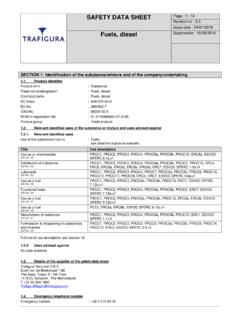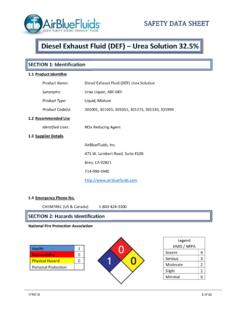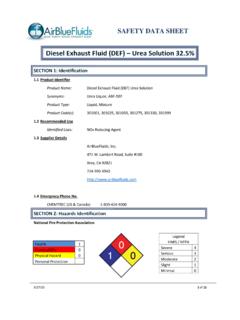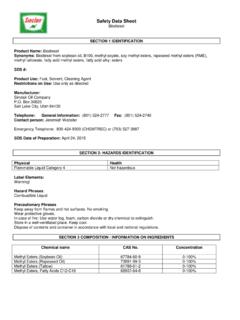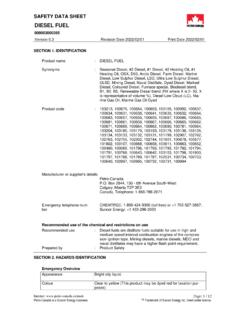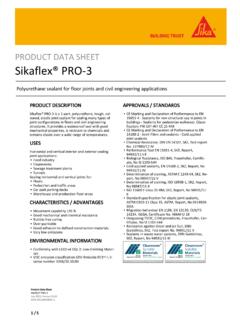Transcription of Safety Data Sheet
1 Safety data Sheet Product Name: Automotive diesel Fuel Reference No: CAL0027601 Issued: 2016-07-01 Version: Page 1 of 8 Hazardous Substance, Non-Dangerous Goods 1. MATERIAL AND SUPPLY COMPANY IDENTIFICATION Product name: Automotive diesel Fuel Synonyms Product Code Active TecD Alpine diesel XLSD Clean TecD diesel Fuel Unmarked Extra Low Sulphur diesel Highland diesel XLSD Power TecD Vortex Premium diesel Recommended use: Fuel. Supplier: Caltex Australia Petroleum Pty Ltd ABN: 17 000 032 128 Street Address: 2 Market Street Sydney NSW 2000 Australia Telephone: +612 9250-5000 Facsimile: +612 9250-5742 Emergency telephone number: 1800 033 111 2. HAZARDS IDENTIFICATION This material is hazardous according to health criteria of Safe Work Australia. Signal Word Danger Hazard Classifications Flammable Liquids - Category 4 Acute Toxicity - Oral - Category 4 Aspiration Hazard - Category 1 Skin Corrosion/Irritation - Category 2 Carcinogenicity - Category 2 Specific Target Organ Toxicity (Repeated Exposure) - Category 2 Chronic Hazard to the Aquatic Environment - Category 2 Hazard Statements H227 Combustible liquid.
2 H302 Harmful if swallowed. H304 May be fatal if swallowed and enters airways. H315 Causes skin irritation. H351 Suspected of causing cancer. H373 May cause damage to organs through prolonged or repeated exposure. Safety data Sheet Product Name: Automotive diesel Fuel Reference No: CAL0027601 Issued: 2016-07-01 Version: Page 2 of 8 H411 Toxic to aquatic life with long lasting effects. Prevention Precautionary Statements P102 Keep out of reach of children. P103 Read label before use. P201 Obtain special instructions before use. P202 Do not handle until all Safety precautions have been read and understood. P210 Keep away from heat/sparks/open flames/hot surfaces. No smoking. P260 Do not breathe dust, fume, gas, mist, vapours or spray. P264 Wash hands, face and all exposed skin thoroughly after handling. P270 Do not eat, drink or smoke when using this product.
3 P281 Use personal protective equipment as required. Response Precautionary Statements P101 If medical advice is needed, have product container or label at hand. P301+P310 IF SWALLOWED: Immediately call a POISON CENTER or doctor/physician. P302+P352 IF ON SKIN: Wash with plenty of soap and water. P314 Get medical advice/attention if you feel unwell. P362 Take off contaminated clothing and wash before reuse. Storage Precautionary Statements P403+P235 Store in a well-ventilated place. Keep cool. P405 Store locked up. Disposal Precautionary Statement P501 Dispose of contents/container in accordance with local, regional, national and international regulations. Poison Schedule: S5. Caution DANGEROUS GOOD CLASSIFICATION Not classified as Dangerous Goods by the criteria of the Australian Code for the Transport of Dangerous Goods by Road & Rail and the New Zealand NZS5433: Transport of Dangerous Goods on Land.
4 Classified as a C1 (COMBUSTIBLE LIQUID) for the purpose of storage and handling, in accordance with the requirements of AS 1940. Refer to State Regulations for storage and transport requirements. 3. COMPOSITION INFORMATION CHEMICAL ENTITY CAS NO PROPORTION Fuels, diesel 68334-30-5 95 - 100 % Methyl esters from lipid sources 67784-80-9 0 - 5 % 100 % 4. FIRST AID MEASURES If poisoning occurs, contact a doctor or Poisons Information Centre (Phone Australia 131 126, New Zealand 0800 764 766). Inhalation: Remove victim from exposure - avoid becoming a casualty. Remove contaminated clothing and loosen remaining clothing. Allow patient to assume most comfortable position and keep warm. Keep at rest until fully recovered. Seek medical advice if effects persist. Skin Contact: If skin or hair contact occurs, immediately remove contaminated clothing and flush skin and hair with running water.
5 Continue flushing with water until advised to stop by the Poisons Information Centre or a Doctor; or for 15 minutes and transport to Doctor or Hospital. For gross contamination, immediately drench with Safety data Sheet Product Name: Automotive diesel Fuel Reference No: CAL0027601 Issued: 2016-07-01 Version: Page 3 of 8 water and remove clothing. Continue to flush skin and hair with plenty of water (and soap if material is insoluble). For skin burns, cover with a clean, dry dressing until medical help is available. If blistering occurs, do NOT break blisters. If swelling, redness, blistering, or irritation occurs seek medical assistance. Eye contact: If in eyes wash out immediately with water. In all cases of eye contamination it is a sensible precaution to seek medical advice. Ingestion: Immediately rinse mouth with water. If swallowed, do NOT induce vomiting.
6 Give a glass of water to drink. Never give anything by the mouth to an unconscious patient. If vomiting occurs give further water. Immediately call Poisons Centre or Doctor. Notes to physician: Treat symptomatically. 5. FIRE FIGHTING MEASURES Hazchem Code: Not Applicable Suitable extinguishing media: If material is involved in a fire use water fog (or if unavailable fine water spray), foam, dry agent (carbon dioxide, dry chemical powder). Specific hazards: Combustible liquid. Fire fighting further advice: On burning may emit toxic fumes. Fire fighters to wear self-contained breathing apparatus and suitable protective clothing if risk of exposure to vapour or products of combustion. 6. ACCIDENTAL RELEASE MEASURES SMALL SPILLS Wear protective equipment to prevent skin and eye contamination. Avoid inhalation of vapours or dust. Wipe up with absorbent (clean rag or paper towels).
7 Collect and seal in properly labelled containers or drums for disposal. LARGE SPILLS If safe to do so, shut off all possible sources of ignition. Clear area of all unprotected personnel. Slippery when spilt. Avoid accidents, clean up immediately. Wear protective equipment to prevent skin and eye contamination and the inhalation of vapours. Work up wind or increase ventilation. Contain - prevent run off into drains and waterways. Use absorbent (soil, sand or other inert material). Use a spark-free shovel. Collect and seal in properly labelled containers or drums for disposal. If contamination of crops, sewers or waterways has occurred advise local emergency services. Dangerous Goods Initial Emergency Response Guide No: Not Applicable 7. HANDLING AND STORAGE Handling: Avoid eye contact and skin contact. Avoid inhalation of vapour, mist or aerosols.
8 Storage: Store in a cool, dry, well-ventilated place and out of direct sunlight. Store away from foodstuffs. Store away from incompatible materials described in Section 10. Store away from sources of heat and/or ignition. Store locked up. Keep container standing upright. Keep containers closed when not in use - check regularly for leaks. Classified as a C1 (COMBUSTIBLE LIQUID) for the purpose of storage and handling, in accordance with the requirements of AS 1940. Refer to State Regulations for storage and transport requirements. This material is a Scheduled Poison Schedule 5 (Caution) and must be stored, maintained and used in accordance with the relevant regulations. Safety data Sheet Product Name: Automotive diesel Fuel Reference No: CAL0027601 Issued: 2016-07-01 Version: Page 4 of 8 8. EXPOSURE CONTROLS / PERSONAL PROTECTION National occupational exposure limits: TWA STEL NOTICES ppm mg/m3 ppm mg/m3 Oil mist, refined mineral - 5 - - - As published by Safe Work Australia.
9 TWA - The time-weighted average airborne concentration over an eight-hour working day, for a five-day working week over an entire working life. STEL (Short Term Exposure Limit) - the average airborne concentration over a 15 minute period which should not be exceeded at any time during a normal eight-hour workday. These Exposure Standards are guides to be used in the control of occupational health hazards. All atmospheric contamination should be kept too as low a level as is workable. These exposure standards should not be used as fine dividing lines between safe and dangerous concentrations of chemicals. They are not a measure of relative toxicity. If the directions for use on the product label are followed, exposure of individuals using the product should not exceed the above standard. The standard was created for workers who are routinely, potentially exposed during product manufacture.
10 Biological Limit Values: As per the National Model Regulations for the Control of Workplace Hazardous Substances (Safe Work Australia) the ingredients in this material do not have a Biological Limit Allocated. Engineering Measures: Ensure ventilation is adequate to maintain air concentrations below Exposure Standards. Use only in well ventilated areas. Use with local exhaust ventilation or while wearing appropriate respirator. Vapour heavier than air - prevent concentration in hollows or sumps. Do NOT enter confined spaces where vapour may have collected. Personal Protection Equipment: Safety SHOES, OVERALLS, GLOVES, Safety GLASSES. Wear Safety shoes, overalls, gloves, Safety glasses. Available information suggests that gloves made from nitrile rubber should be suitable for intermittent contact. However, due to variations in glove construction and local conditions, the user should make a final assessment.

